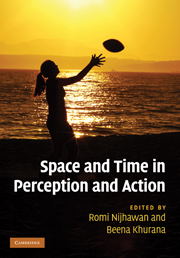Book contents
- Frontmatter
- Contents
- List of contributors
- Acknowledgments
- 1 Space and time: the fabric of thought and reality
- Part I Time–space during action: perisaccadic mislocalization and reaching
- Part II Temporal phenomena: perception
- Part III Temporal phenomena: binding and asynchrony
- Part IV Spatial phenomena: forward shift effects
- 19 The Fröhlich effect: past and present
- 20 Approaches to representational momentum: theories and models
- 21 Conceptual influence on the flash-lag effect and representational momentum
- 22 Perceptual asynchronies and the dual-channel differential latency hypothesis
- 23 Paying attention to the flash-lag effect
- 24 Illusions of time, space, and motion: flash-lag meets chopsticks and reversed phi
- 25 Bridging the gap: a model of common neural mechanisms underlying the Fröhlich effect, the flash-lag effect, and the representational momentum effect
- 26 Perceiving-the-present and a unifying theory of illusions
- 27 History and theory of flash-lag: past, present, and future
- Part V Space–time and awareness
- Index
- References
25 - Bridging the gap: a model of common neural mechanisms underlying the Fröhlich effect, the flash-lag effect, and the representational momentum effect
from Part IV - Spatial phenomena: forward shift effects
Published online by Cambridge University Press: 05 October 2010
- Frontmatter
- Contents
- List of contributors
- Acknowledgments
- 1 Space and time: the fabric of thought and reality
- Part I Time–space during action: perisaccadic mislocalization and reaching
- Part II Temporal phenomena: perception
- Part III Temporal phenomena: binding and asynchrony
- Part IV Spatial phenomena: forward shift effects
- 19 The Fröhlich effect: past and present
- 20 Approaches to representational momentum: theories and models
- 21 Conceptual influence on the flash-lag effect and representational momentum
- 22 Perceptual asynchronies and the dual-channel differential latency hypothesis
- 23 Paying attention to the flash-lag effect
- 24 Illusions of time, space, and motion: flash-lag meets chopsticks and reversed phi
- 25 Bridging the gap: a model of common neural mechanisms underlying the Fröhlich effect, the flash-lag effect, and the representational momentum effect
- 26 Perceiving-the-present and a unifying theory of illusions
- 27 History and theory of flash-lag: past, present, and future
- Part V Space–time and awareness
- Index
- References
Summary
Summary
In recent years, the study and interpretation of mislocalization phenomena observed with moving objects have caused an intense debate about the processing mechanisms underlying the encoding of position. We use a neurophysiologically plausible recurrent network model to explain visual illusions that occur at the start, midposition, and end of motion trajectories known as the Fröhlich, the flash-lag, and the representational momentum effect, respectively. The model implements the idea that trajectories are internally represented by a traveling activity wave in position space, which is essentially shaped by local feedback loops within pools of neurons. We first use experimentally observed trajectory representations in the primary visual cortex of cat to adjust the spatial ranges of lateral interactions in the model. We then show that the readout of the activity profile at adequate points in time during the build-up, midphase, and decay of the wave qualitatively and quantitatively explain the known dependence of the mislocalization errors on stimulus attributes such as contrast and speed. We conclude that cooperative mechanisms within the network may be responsible for the three illusions, with a possible intervention of top-down influences that modulate the efficacy of the lateral interactions.
Introduction
Localizing an object in the presence of motion is a fundamental ability for many species as a moving object often represents danger or food. In recent years, advances in neurophysiology and psychophysics have substantially increased our understanding of how the visual system calculates the present and future positions of moving objects.
Information
- Type
- Chapter
- Information
- Space and Time in Perception and Action , pp. 422 - 440Publisher: Cambridge University PressPrint publication year: 2010
References
Accessibility standard: Unknown
Why this information is here
This section outlines the accessibility features of this content - including support for screen readers, full keyboard navigation and high-contrast display options. This may not be relevant for you.Accessibility Information
- 13
- Cited by
